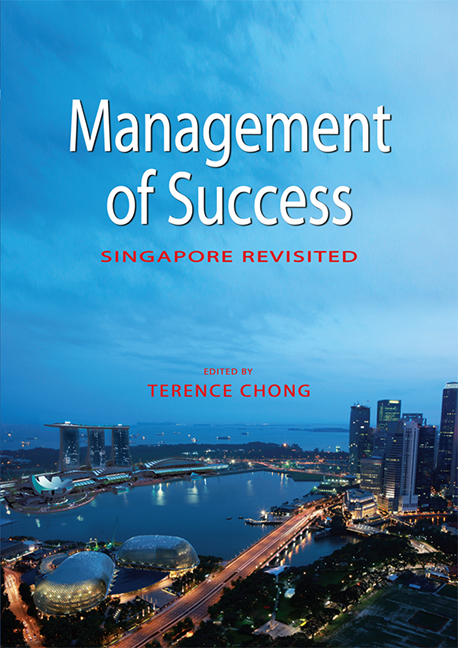Book contents
- Frontmatter
- Contents
- List of Tables and Figures
- Foreword
- Message
- Quote
- Preface
- The Contributors
- 1 Introduction: The Role of Success in Singapore's National Identity
- SECTION 1 SINGAPORE IN THE BIGGER PICTURE
- SECTION 2 LEADERSHIP, POLICY AND POLITICS
- 4 PM Lee Hsien Loong and the “Third Generation” Leadership: Managing Key Nation-building Challenges
- 5 Political Consolidation in Singapore: Connecting the Party, the Government and the Expanding State
- 6 The Evolving Social Compact and the Transformation of Singapore: Going Beyond Quid Pro Quo in Governance
- 7 The Ardour of Tokens: Opposition Parties’ Struggle to Make a Difference
- SECTION 3 THE RESTRUCTURING OF THE ECONOMY
- SECTION 4 THE TRANSFORMATION OF SOCIETY
- SECTION 5 THE LAW
- SECTION 6 MODIFICATION OF THE ENVIRONMENT
- SECTION 7 COMMUNITY AND NATIONAL SECURITY
- SECTION 8 LIFE IN SINGAPORE
- Index
5 - Political Consolidation in Singapore: Connecting the Party, the Government and the Expanding State
from SECTION 2 - LEADERSHIP, POLICY AND POLITICS
Published online by Cambridge University Press: 21 October 2015
- Frontmatter
- Contents
- List of Tables and Figures
- Foreword
- Message
- Quote
- Preface
- The Contributors
- 1 Introduction: The Role of Success in Singapore's National Identity
- SECTION 1 SINGAPORE IN THE BIGGER PICTURE
- SECTION 2 LEADERSHIP, POLICY AND POLITICS
- 4 PM Lee Hsien Loong and the “Third Generation” Leadership: Managing Key Nation-building Challenges
- 5 Political Consolidation in Singapore: Connecting the Party, the Government and the Expanding State
- 6 The Evolving Social Compact and the Transformation of Singapore: Going Beyond Quid Pro Quo in Governance
- 7 The Ardour of Tokens: Opposition Parties’ Struggle to Make a Difference
- SECTION 3 THE RESTRUCTURING OF THE ECONOMY
- SECTION 4 THE TRANSFORMATION OF SOCIETY
- SECTION 5 THE LAW
- SECTION 6 MODIFICATION OF THE ENVIRONMENT
- SECTION 7 COMMUNITY AND NATIONAL SECURITY
- SECTION 8 LIFE IN SINGAPORE
- Index
Summary
THE CONSOLIDATION OF POWER
The continuous dominance of the People's Action Party (PAP) in Singaporean politics is a topic that opens up a plethora of discussion and debate. While many observers have marvelled at Singapore's transformation from Third World to First World status in just one generation under the PAP stewardship, they have noted that its economic success was at the cost of limiting political democratization, curtailing freedom of speech and promoting collectivist ideals and consensual politics. There are a few signs that the PAP's consolidation of political power will dissipate in the near future when the forces of globalization and democratization knock at its door. In the 1989 volume of Management of Success, Chan Heng Chee's chapter on the local political system concluded that “the administrative [PAP] state of the 1970s has undergone some modification. The de-politicization of the recent past has been replaced by a re-politicization of the citizenry. Successful mass education, as well as the open economy, can directly contribute to increased political cognition and a sense of personal efficacy. This seems to be the case in Singapore. How will the Singapore political system further develop?”
This chapter seeks to answer Chan's question by uncovering some of the nuances of governance in Singapore, primarily by sorting out the overlapping and mutually reinforcing roles of party, government and state, so as to draw some logical conclusions for PAP's political consolidation in the city-state. Distinctions are made between these political structures to examine the strategies culminating in the PAP's successful legitimization and entrenchment of its authority. A number of questions are raised: how has the PAP, voted into power in 1959, managed to convince the citizenry of its relevance through the years? How have state authorities perpetuated a seemingly paradoxical situation where political control seems to be both tighter and freer at the same time? In short, what strategies has the PAP deployed to consolidate its rule?
The general argument of this chapter is that the PAP has expanded governmental institutions by institutionalizing them as state apparatus to consolidate the interest of the political party in power.
- Type
- Chapter
- Information
- Management of SuccessSingapore Revisited, pp. 67 - 79Publisher: ISEAS–Yusof Ishak InstitutePrint publication year: 2010



